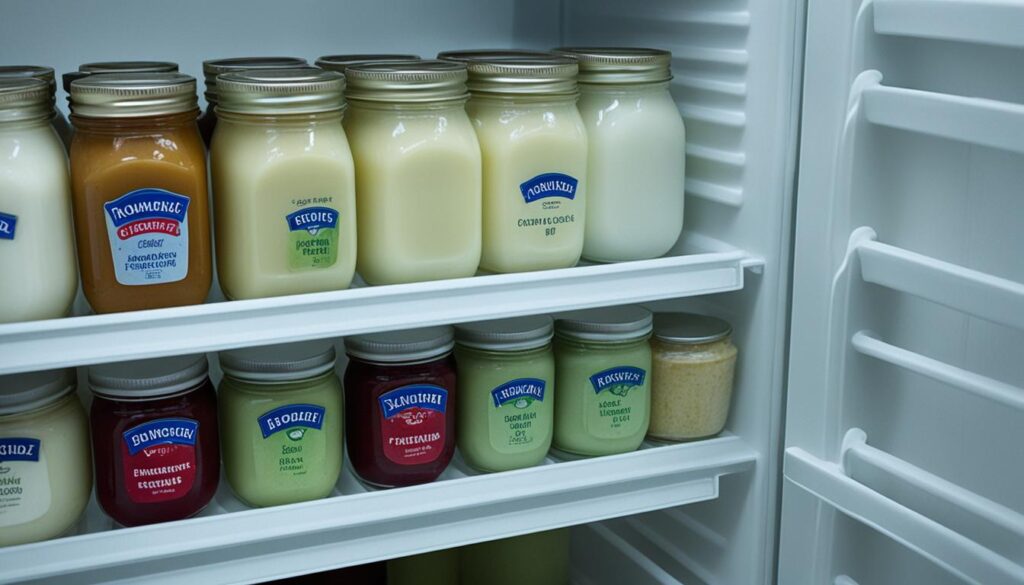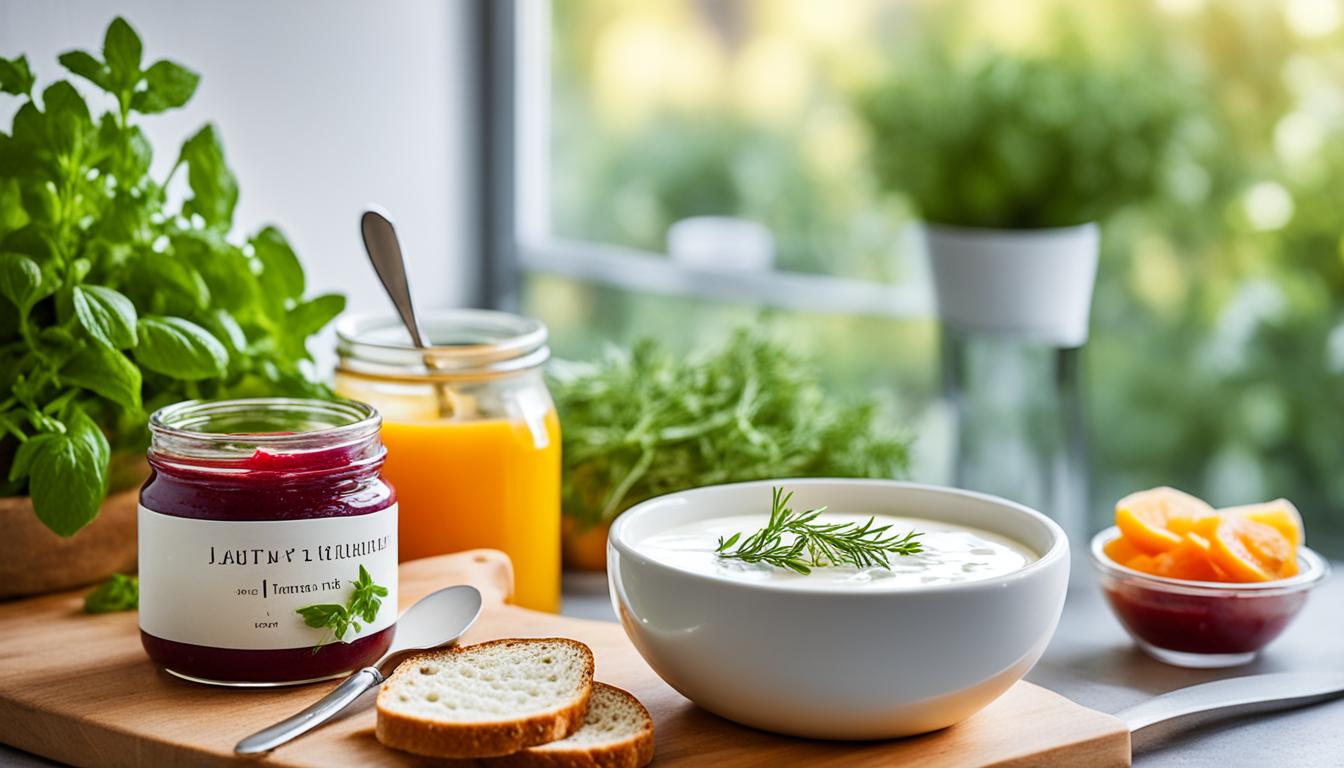Have you ever wondered how to make creme fraiche at home? Is it a complicated process that requires special equipment and ingredients? Well, we’re here to tell you that making homemade creme fraiche is surprisingly simple and can be done with just a few easy steps.
Forget about the store-bought versions, packed with preservatives and artificial additives. With our DIY creme fraiche recipe, you can create a creamy and tangy masterpiece in the comfort of your own kitchen.
But where do you start? How do you achieve that perfect texture and flavor? And what exactly is the secret ingredient that makes it all come together? Keep reading as we unravel the mysteries of homemade creme fraiche and guide you through the process step-by-step.
The History of Crème Fraiche and Its French Roots
In order to truly appreciate crème fraîche, it is essential to understand its rich history and French origins. This luscious and creamy dairy product has a long-standing tradition in French cuisine, dating back centuries.
Crème fraîche originated in France, where it was traditionally made by allowing fresh cow’s cream to stay at room temperature and naturally ferment. The cream would thicken and acidify as the naturally occurring bacteria cultures in the air took hold. This process not only prevented the cream from spoiling, but it also developed the distinct tangy flavor that crème fraîche is known for.
In the past, crème fraîche was commonly made by leaving the cream in a cool cellar or on the kitchen counter, taking advantage of the ambient temperature. The controlled fermentation allowed the cream to transform into a thick, silky, and slightly tangy delight.
This traditional method of making crème fraîche without refrigeration was particularly advantageous in pre-refrigeration times when cooling and preserving dairy products was a challenge. The French recognized the value of this souring process, extending the shelf life of cream and creating a versatile culinary ingredient.
“Crème fraîche has a rich history in French cuisine, where it has been treasured for its creamy texture and tangy flavor. Its origins lie in the simple act of allowing fresh cream to sour naturally, resulting in a versatile ingredient that enhances both sweet and savory dishes.”
However, with the advent of pasteurization and modern refrigeration techniques, the way crème fraîche is made has evolved. To ensure consistency and control in the fermentation process, crème fraîche is now made with the addition of lactic cultures from buttermilk or yogurt. These external cultures help replicate the natural fermentation process, resulting in a creamy, tangy, and perfectly textured crème fraîche.
This modern adaptation not only ensures food safety but also widens the availability of crème fraîche to a broader audience. It allows for the creation of homemade crème fraîche that captures the essence of the traditional French delicacy.
Image:
The Simple Process of Making Crème Fraiche at Home
Making crème fraîche at home is incredibly simple. All you need to do is combine cream with a small amount of buttermilk or yogurt and let it rest at room temperature for about 12 hours. The ratio of cream to buttermilk or yogurt can be adjusted to achieve the desired consistency. After the resting period, the cream will have transformed into a thicker and tangier version of itself.
Here are the easy steps for making crème fraîche at home:
- Pour the desired amount of heavy cream into a clean bowl.
- Add a small amount of buttermilk or yogurt to the cream. The general guideline is to use about 1 tablespoon of buttermilk or yogurt for every cup of cream.
- Stir the cream and buttermilk/yogurt mixture together until well combined.
- Cover the bowl with a clean towel or plastic wrap.
- Let the mixture sit at room temperature for approximately 12 hours.
- Check the consistency and taste of the crème fraîche. If it has thickened and developed a tangy flavor, it is ready to be used. If you prefer a thicker consistency, you can let it sit for a few more hours.
Making your own crème fraîche at home allows you to customize the flavor and consistency according to your preference. The process is straightforward, and the result is a rich and creamy addition to your favorite dishes.
With just a few ingredients and a little patience, you can enjoy homemade crème fraîche that rivals the store-bought versions. Give it a try and elevate your culinary creations with this delicious homemade treat.
Tips for Making the Best Homemade Crème Fraiche
When it comes to achieving the best results with homemade crème fraîche, a few tips can make a significant difference. Follow these recommendations to create a creamy and tangy crème fraîche that rivals the store-bought versions:
- Choose the right cream: Opt for pasteurized heavy cream instead of ultra-pasteurized cream. Ultra-pasteurized cream may take longer to sour, affecting the flavor and texture of your crème fraîche.
- Stir it up: During the resting period, make sure to stir the cream and buttermilk or yogurt mixture a few times. This prevents a hard surface from forming on top and promotes even fermentation.
- Experiment with ingredients and time: The flavor and consistency of your homemade crème fraîche can vary based on the type of milk or yogurt used and the length of time it is allowed to sour. Feel free to explore different ratios and fermentation durations to find your preferred results.
Expert Tip:
The quality of your ingredients can greatly impact the outcome of your homemade crème fraîche. Choose high-quality cream and buttermilk or yogurt to ensure the best flavor and texture.
By following these tips, you can elevate your homemade crème fraîche to new heights, achieving a rich and velvety addition to your culinary creations.
Comparing Different Homemade Crème Fraiche Variations
| Type of Milk/Yogurt | Fermentation Time | Resulting Flavor | Consistency |
|---|---|---|---|
| Whole Milk | 24 hours | Mild and slightly tangy | Smooth and pourable |
| Low-fat Yogurt | 12 hours | Light and tangy | Lighter and less thick |
| Greek Yogurt | 24 hours | Tangy and creamy | Thicker and richer |
Creative Uses for Homemade Crème Fraiche
Homemade crème fraîche is a versatile ingredient that can elevate both sweet and savory dishes. Its creamy and tangy flavor adds a unique touch to various recipes. Here are some creative ways to incorporate homemade crème fraîche into your cooking:
1. Sweet Delights
For a luscious dessert, spoon homemade crème fraîche over fresh fruits such as berries, peaches, or pineapple. The creamy texture and tangy taste complement the natural sweetness of the fruit. You can also dollop it onto pancakes, waffles, or French toast for a decadent breakfast treat.
2. Savory Creations
Stir homemade crème fraîche into pan sauces to add richness and depth of flavor. It works particularly well in creamy pasta sauces, enhancing the creaminess and providing a hint of tanginess. Crème fraîche also brings a delightful nutty taste when mixed into soups like tomato or butternut squash. Don’t forget to add a dollop of crème fraîche to creamy mashed potatoes for a velvety texture and a touch of tang.
3. Fish and Eggs
Add a zesty twist to your fish dishes by mixing crème fraîche with lemon zest and fresh herbs such as dill or chives. Serve this tangy sauce alongside fish fillets or spread it on top before baking. Crème fraîche is also an excellent addition to scrambled eggs. Incorporating it into your eggs will result in a creamier and more luxurious texture.
“Homemade crème fraîche brings a creamy and tangy dimension to both sweet and savory dishes, making it a versatile ingredient in the kitchen.”
These are just a few ideas to get you started. Feel free to experiment with your favorite recipes and explore the endless possibilities of incorporating homemade crème fraîche. Its creamy texture and tangy flavor can enhance a wide range of dishes, from desserts to main courses.
Substitutes for Crème Fraiche
If crème fraîche is not available or you prefer to use a substitute, there are several alternatives that can be used interchangeably in most recipes. Here are some popular substitutes for crème fraîche:
- Sour cream: Sour cream is a popular substitute for crème fraîche. It is thicker and more stable in texture, making it a suitable replacement. However, keep in mind that sour cream has a slightly tangier flavor compared to crème fraîche.
- Greek yogurt: Greek yogurt is another excellent alternative to crème fraîche. It provides a tangy flavor and a creamy texture that can mimic the characteristics of crème fraîche in recipes. Greek yogurt is also a healthier option as it is high in protein and lower in fat.
- Heavy cream: If you have heavy cream available, it can be used as a substitute for crème fraîche. However, keep in mind that heavy cream lacks the tangy flavor that crème fraîche offers. You may consider adding a small amount of lemon juice or vinegar to replicate the tanginess.
Note: For dairy-free alternatives to crème fraîche, you can try using vegan sour cream, rich coconut yogurt, or coconut cream. These options can provide similar texture and flavor profiles for those with dietary restrictions.
Experiment with these substitutes to find the one that best suits your taste preferences and recipe requirements. While they may not be an exact match for crème fraîche, they can still add richness and creaminess to your dishes.
Incorporating these alternatives to crème fraîche into your recipes opens up a world of possibilities. Enjoy the versatility and convenience of these substitutes while still achieving delicious results in your cooking.
Storage and Shelf Life of Homemade Crème Fraiche
Once you’ve made your delicious homemade crème fraîche, proper storage is essential to maintain its quality and freshness. Here are some tips:
Storing Homemade Crème Fraiche
- Transfer the crème fraîche to an airtight container.
- Ensure that the lid is tightly sealed to prevent air from entering.
- Place the container in the refrigerator.
By following these steps, you can keep your homemade crème fraîche safely stored and ready to use whenever you need it.
Shelf Life of Homemade Crème Fraiche
Homemade crème fraîche typically has a shelf life of around seven to ten days when stored properly in the refrigerator. This duration allows you plenty of time to incorporate it into various recipes and enjoy its creamy goodness.
It’s worth noting that as crème fraîche sits in the refrigerator, its texture and flavor may continue to develop and thicken. This can be a desirable change for some, as it intensifies its tanginess and richness.
Check out the table below for a summary on storing and shelf life of homemade crème fraiche:
| Storing Homemade Crème Fraiche | Shelf Life |
|---|---|
| Transfer to an airtight container | Around 7-10 days in the refrigerator |
| Ensure tight seal | Texture and flavor may develop and thicken |

Conclusion
Making crème fraîche at home is a simple and cost-effective way to enjoy this creamy and tangy ingredient. With just a few ingredients and a little patience, you can create a homemade version that can elevate both sweet and savory dishes.
Experimenting with different ratios of cream to buttermilk or yogurt allows you to find your desired consistency and flavor. Whether you prefer a thicker or more tangy crème fraîche, you have the flexibility to customize it to your taste.
The rich finish that homemade crème fraîche adds to your favorite recipes is unmatched. From topping fresh fruit and pancakes to enhancing pan sauces and mashed potatoes, this versatile ingredient can take your dishes to the next level.
So why settle for store-bought crème fraîche when you can easily make it at home? Enjoy the satisfaction of creating your own delicious and flavorful crème fraîche that will impress both your friends and family.
